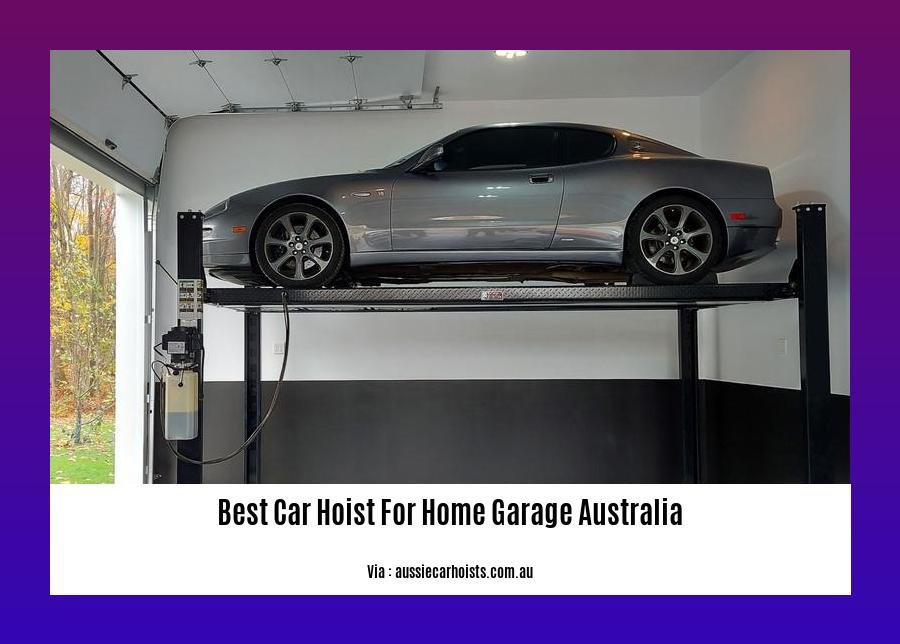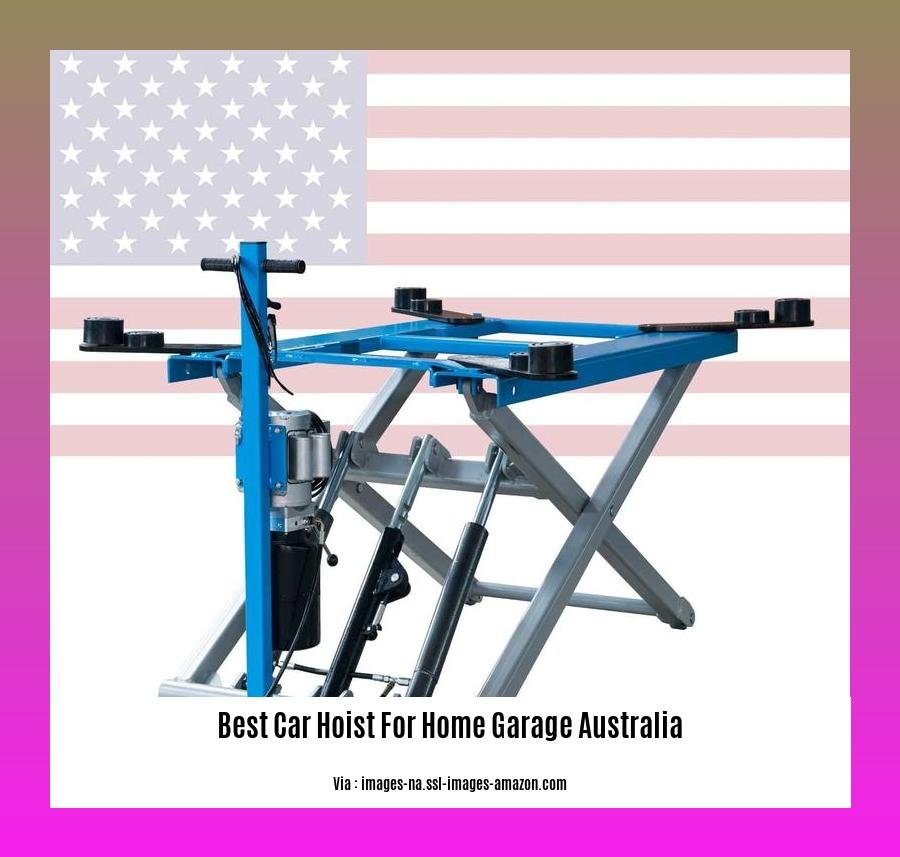With the growing popularity of DIY car maintenance and modifications, the need for reliable car hoists has become more prominent in Australian home garages. The Ultimate Guide to Choosing the Best Car Hoist for Your Home Garage in Australia provides valuable insights and expert advice to help you select the perfect car hoist that suits your needs, safety requirements, and budget. Whether you’re a seasoned automotive enthusiast or just starting out, this comprehensive guide will empower you with the knowledge and confidence to make an informed decision and elevate your home garage experience.
Key Takeaways:
-
The best car hoists of 2023 include APlusLift HW-10KBP, QuickJack BL-5000SLX, APlusLift HW-10KOH, BendPak MD-6XP, BendPak XPR-10AXLS, Triumph NSS-8, and Triumph NT-9FP.
-
When selecting a car hoist, consider your vehicle’s weight, garage height, and intended tasks.
-
Features to consider include weight capacity, lifting range, portability, height adjustability, and safety features.
-
Ensure proper installation and maintenance of the chosen hoist.
Choosing the Best Car Hoist for Home Garage Australia**

Owning a car hoist in your home garage can significantly enhance your automotive maintenance and repair capabilities. Whether you’re a seasoned car enthusiast or a DIY enthusiast, selecting the right car hoist is crucial to ensuring safety, efficiency, and satisfaction. Read on for a comprehensive guide to choosing the best car hoist for home garage Australia.
Types of Car Hoists
- Two-Post Car Hoists:
- Commonly used in home garages due to their compact size and ease of installation.
- Consists of two posts anchored to the floor, supporting a lifting mechanism that raises the vehicle.
-
Ideal for smaller vehicles like sedans and coupes.
-
Four-Post Car Hoists:
- Offers more stability and weight capacity compared to two-post hoists.
- Consists of four posts, each anchored to the floor, supporting a lifting platform.
-
Suitable for heavier vehicles such as SUVs, trucks, and vans.
-
Scissor Car Hoists:
- Employs a scissor-like mechanism to lift vehicles.
- Compact and suitable for low-ceiling garages.
-
Ideal for occasional lifting tasks such as oil changes and tire rotations.
-
Portable Car Hoists:
- Designed for easy transport and storage.
- Typically operated hydraulically or pneumatically.
- Suitable for quick lifting tasks or use in multiple locations.
Factors to Consider
- Weight Capacity:
- Determine the weight of your vehicle and choose a hoist with a capacity exceeding that weight.
-
Consider future vehicle upgrades or changes.
-
Lifting Height:
- Ensure the hoist has a lifting range that accommodates the height of your vehicle.
-
Consider additional clearance for modifications or maintenance tasks.
-
Garage Space:
- Measure the available space in your garage and choose a hoist that fits comfortably.
-
Consider the location of doors, windows, and other potential obstructions.
-
Power Requirements:
- Determine the power source available in your garage (e.g., 110V or 220V).
-
Choose a hoist that is compatible with your power supply.
-
Safety Features:
- Look for hoists equipped with safety features like automatic locks, safety latches, and overload protection.
- Ensure the hoist complies with Australian safety standards.
Top Brands in Australia
-
APlusLift: Renowned for producing high-quality car hoists with various models to suit different needs.
-
QuickJack: Known for their portable car hoists, ideal for home garages with limited space.
-
BendPak: Offers a wide range of car hoists, including two-post, four-post, and scissor lifts.
-
Triumph: Provides a variety of car hoists, including two-post and four-post models, known for their durability and reliability.
Choosing the Right Hoist
- Research and Compare:
- Gather information about different types, brands, and models of car hoists available in Australia.
-
Compare their features, specifications, and prices to find the one that best suits your requirements.
-
Read Reviews:
-
Look for reviews from other car enthusiasts and experts to gain insights into the performance, reliability, and customer satisfaction of specific hoists.
-
Consider Your Budget:
- Set a budget for your car hoist purchase and stick to it.
-
Remember that quality and safety should not be compromised for a lower price.
-
Professional Installation:
- Engage qualified professionals for the installation of your car hoist.
- Improper installation can be dangerous and void manufacturer warranties.
Conclusion
Selecting the best car hoist for home garage Australia requires careful consideration of your needs, garage space, and budget. By following the steps and factors outlined in this guide, you can make an informed decision that enhances your automotive maintenance and repair capabilities while ensuring safety and efficiency. Remember to always prioritize safety and consult with experts when necessary.
-
For the most reliable and long-lasting vehicle lifts for your home garage in the UK, check out our guide to the best car lift for home garage UK.
-
When it comes to building your dream home in Dallas-Fort Worth, trust only the best custom home builders in DFW for exceptional craftsmanship and personalized service.
-
Experience the pinnacle of luxury and comfort with Florida’s top-rated best custom home builders in Florida, creating masterpieces that redefine living standards.
-
From classic designs to contemporary masterpieces, discover the best custom home builders in Georgia who bring your unique vision to life with precision and artistry.
-
Transform your Houston dream into reality with the assistance of the best custom home builders in Houston, renowned for their expertise in creating exceptional living spaces.
-
Houston homeowners, elevate your living experience with the expertise of the best home builders in Houston, renowned for their commitment to quality and innovation.
Factors to Consider When Choosing a Car Hoist

When selecting the ideal car hoist for your home garage in Australia, several key factors demand your attention:
1. Available Space:
- Assess the dimensions of your garage to determine the maximum hoist size that can be accommodated without hindering movement or overcrowding the space.
2. Weight Capacity:
- Ensure the hoist’s weight capacity exceeds your vehicle’s weight. Consider potential future vehicle upgrades that may require a higher weight capacity.
- Calculate your vehicle’s weight accurately, including fluids, passengers, and cargo, to select a hoist with an appropriate rating.
3. Compatibility:
- Verify the hoist’s compatibility with your vehicle type and model. Some hoists are designed specifically for cars, trucks, or SUVs, while others are suitable for a broader range of vehicles.
- Check the vehicle’s height and wheelbase to ensure it fits within the hoist’s lifting range and dimensions.
4. Budget:
- Determine your budget for the car hoist, considering both the initial purchase price and any additional costs for installation, maintenance, or future upgrades.
- Strike a balance between your desired features and safety requirements while staying within your financial limits.
5. Features & Safety:
- Research various hoist features that enhance safety, convenience, and functionality, such as dual hydraulic cylinders for stability, adjustable lifting heights, and safety locks.
- Investigate options for lifting different types of vehicles, including low-profile or classic cars, if applicable.
- Consider the availability of spare parts and technical support from the hoist manufacturer or local suppliers.
Key Takeaways:
-
Available Space: Consider the dimensions of your garage and select a hoist size that fits without overcrowding or hindering movement.
-
Weight Capacity: Ensure the hoist’s weight capacity exceeds your vehicle’s weight, accounting for potential future upgrades and accurate calculations.
-
Compatibility: Verify the hoist’s compatibility with your vehicle type and model, ensuring it fits within the lifting range and dimensions.
-
Budget: Determine your budget, considering the initial purchase price and potential additional costs, while balancing desired features and safety requirements.
-
Features & Safety: Investigate hoist features that enhance safety, convenience, and functionality, such as dual hydraulic cylinders, adjustable lifting heights, and safety locks.
Sources:
- How to Choose the Right Car Hoist
- Factors to Consider When Choosing a Car Hoist
Types of Car Hoists:
In the realm of automotive maintenance and repair, car hoists have become indispensable tools for enthusiasts and professionals alike. These versatile devices allow you to elevate your vehicle, providing convenient access to its undercarriage for various tasks. Whether you’re a seasoned mechanic or simply passionate about maintaining your own vehicles, selecting the right car hoist is crucial for ensuring safety, efficiency, and satisfaction. As we delve into the world of car hoists, let’s explore the different types available and the factors to consider when making your choice.
1. Two-Post Car Hoists:
Two-post car hoists, often referred to as “above-ground” or “asymmetric” hoists, are commonly found in home garages and workshops due to their versatility and space-saving design. These hoists comprise two sturdy columns with hydraulic or electric actuators that lift the vehicle from two points, typically located near the front and rear wheels.
Advantages:
- Compact Design: Two-post hoists occupy minimal floor space, making them suitable for smaller garages or workshops.
- Versatile Usage: They can be used for a wide range of tasks, including general maintenance, repairs, and tire changes.
- Easy Accessibility: The open design provides unobstructed access to the vehicle’s undercarriage, facilitating efficient work.
Disadvantages:
- Weight Limitations: Two-post hoists have lower weight capacities compared to other types, limiting their suitability for heavier vehicles.
- Limited Lifting Height: The lifting height may be restricted, potentially hindering certain tasks that require significant clearance.
2. Four-Post Car Hoists:
Four-post car hoists, also known as “full-rise” or “symmetric” hoists, provide a stable and secure platform for lifting vehicles. These hoists feature four columns, each equipped with hydraulic or electric actuators, which raise the vehicle from four points, usually positioned at each corner.
Advantages:
- Stability and Safety: Four-post hoists offer exceptional stability and safety due to their wider stance and balanced lifting mechanism.
- High Weight Capacity: They can accommodate heavier vehicles, making them ideal for trucks, SUVs, and other larger vehicles.
- Ample Clearance: The full-rise design provides ample clearance, allowing you to perform tasks that require significant vertical space.
Disadvantages:
- Larger Footprint: Four-post hoists require more floor space compared to two-post hoists, making them less suitable for smaller garages.
- Cost: They are generally more expensive than two-post hoists due to their larger size and more complex design.
3. Scissor Car Hoists:
Scissor car hoists, also known as “low-rise” or “portable” hoists, offer a compact and versatile solution for lifting vehicles in tight spaces. These hoists utilize a scissor-like mechanism that raises the vehicle from below, making them ideal for garages with low ceilings or limited headroom.
Advantages:
- Compact Design: Scissor hoists have a low profile and require minimal overhead clearance, making them suitable for garages with limited space.
- Portability: They are often portable, allowing you to move them around the garage or workshop easily.
- Easy Storage: When not in use, scissor hoists can be folded or stored vertically, saving valuable floor space.
Disadvantages:
- Lower Weight Capacity: Scissor hoists typically have lower weight capacities compared to other types, limiting their suitability for heavier vehicles.
- Limited Lifting Height: The lifting height may be restricted, making them less suitable for tasks that require significant clearance.
4. Single-Post Car Hoists:
Single-post car hoists provide a space-saving solution for lifting compact cars and performing basic maintenance tasks. These hoists consist of a single column with a hydraulic or electric actuator that lifts the vehicle from a single point, usually located near the center of the vehicle.
Advantages:
- Compact Design: Single-post hoists have a minimal footprint, making them ideal for garages with extremely limited space.
- Affordability: They are generally more affordable than other types of car hoists, making them a budget-friendly option.
- Easy Installation: Single-post hoists are relatively easy to install, requiring less time and effort compared to other types.
Disadvantages:
- Weight and Size Limitations: Single-post hoists have lower weight capacities and are suitable only for smaller vehicles.
- Limited Accessibility: The single lifting point may limit access to certain areas of the vehicle’s undercarriage.
Key Takeaways:
-
Space Optimization: Car hoists allow you to store vehicles vertically, saving valuable floor space in your garage or workshop.
-
Improved Accessibility: Hoists provide easy access to the underside of your vehicle, facilitating maintenance, repairs, and cleaning tasks.
-
Versatility: Car hoists are suitable for various purposes, including storage, maintenance, repairs, and modifications.
-
Safety Considerations: Always follow proper safety guidelines and ensure that the hoist is installed and maintained correctly to prevent accidents.
-
Choose the Right Type: Consider the type of vehicles you own, the tasks you intend to perform, and the available space in your garage when selecting a car hoist.
Sources:
-
AAQaaq.net.au – What Is The Best Car Hoist For Home Garages?
-
Garage Equipment – AU Standard Vehicle Hoists in Home Workshop
FAQ
Q1: What key factors should I consider when selecting a car hoist for my home garage in Australia?
A1: When choosing a car hoist for your home garage in Australia, several key factors to consider include the available space, weight capacity, compatibility with your vehicle, budget, and desired features and safety aspects.
Q2: What are the main types of car hoists available, and which one is suitable for my needs?
A2: The primary types of car hoists include two-post car hoists, four-post car hoists, scissor car hoists, and single-post car hoists. The most suitable type for your needs depends on the size, weight, and type of vehicles you will be lifting, the purpose of the hoist (storage, maintenance, or repairs), and the available space in your garage.
Q3: What safety features should I look for in a car hoist for my home garage?
A3: When selecting a car hoist for your home garage, prioritizing safety is crucial. Look for features such as dual hydraulic cylinders for added stability, safety locks to prevent accidental lowering, and emergency stop buttons for quick response in case of any issues. Additionally, ensure that the hoist complies with Australian safety standards and regulations.
Q4: How do I determine the appropriate weight capacity for the car hoist I need?
A4: To determine the appropriate weight capacity for the car hoist you need, consider the weight of the heaviest vehicle you intend to lift. Ensure that the hoist’s weight capacity exceeds the vehicle’s weight by a safe margin. This will provide a buffer and prevent overloading, which can compromise safety and damage the hoist.
Q5: Where can I find reliable information and reviews about car hoists before making a purchase decision?
A5: To find reliable information and reviews about car hoists before making a purchase decision, you can explore reputable automotive websites, online forums, and review platforms. Additionally, seeking advice from experienced mechanics or automotive professionals can provide valuable insights into the performance and reliability of different car hoist models.
- Memorial Stones for Gardens: A Guide to Creating a Lasting Tribute - April 29, 2025
- Melon Cut Diamonds: A Comprehensive Guide - April 29, 2025
- MarketStreet Lynnfield Stores: A Complete Directory & Shopping Guide - April 29, 2025










